The Mercedes V-Class of the 447 series is getting a final update. In addition to optical retouches, there is also a new gasoline engine. In addition, your illuminated radiator grille can now be crowned by a hood ornament, which is otherwise only available on expensive sedans. ntv.de was traveling in the van.
The first encounter with the refreshed V-Class was quite relaxing. Mercedes didn't miss the opportunity to use them as a shuttle from the airport and invited the troops to sit in the comfortable luxury seats (which cost more than 5,000 euros extra!) when they arrived. It's also nice to let yourself be driven.
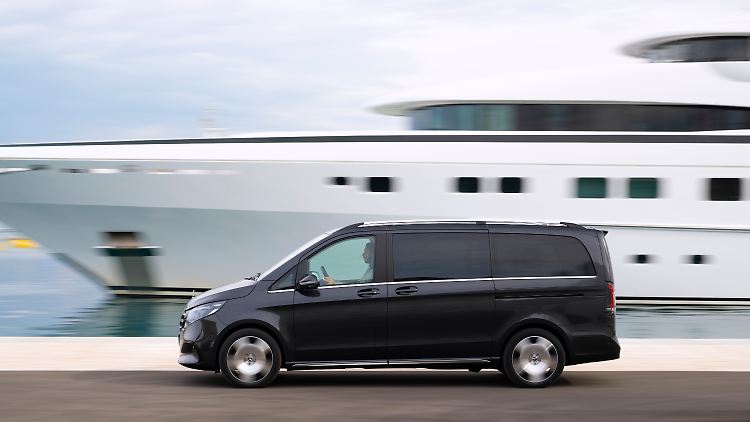

The long version, measuring 5.14 meters, appears expansive. It's even longer at 5.37 meters, but also much more compact at 4.90 meters.
(Photo: Mercedes)
I lean back comfortably, listen to the four-cylinder diesel and enjoy the air suspension, which is subject to an additional charge. Nothing more than a quiet murmur penetrates the spacious interior and the chassis acts gently, as if the van, blessed with a 3.20 meter long wheelbase, was floating on clouds. On the small tables in the middle there are champagne glasses with a metal core in them so that they are stabilized with a magnet. If the driver slams on the brakes, the drink will spill over the edge of the glass – and hopefully not stain the velvety covers of the headrests. Massage function or air conditioning of the upholstery? Of course, it's not only available in the S-Class, but also in this luxurious van.
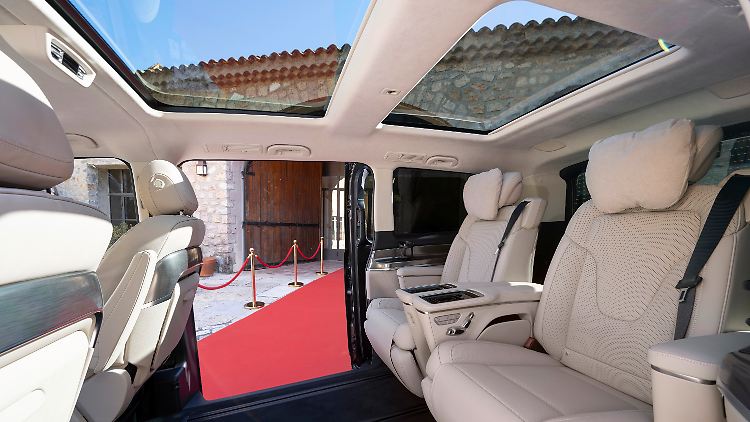

It's great to sit in the expensive luxury seats. Of course, six more people won't fit in the rear compartment.
(Photo: Mercedes)
But I'll be honest, I don't want to be chauffeured at all. That can be quite funny, but I'm more of a driver type. So at some point I take the seat behind the wheel, which is quite comfortable to be behind. Of course, there will be V-Classes that will be driven by chauffeurs – but in much more common cases, only decently well-off family fathers and mothers will be considered as drivers. And then probably without luxury seats at the back, but with very solid and comfortable armchairs at the front (which are standard, by the way) plus good all-round visibility. And with up to eight seats in total. Of course, the V-Class is bursting with practicality. But which engine should it be?
Confident in the strongest variants
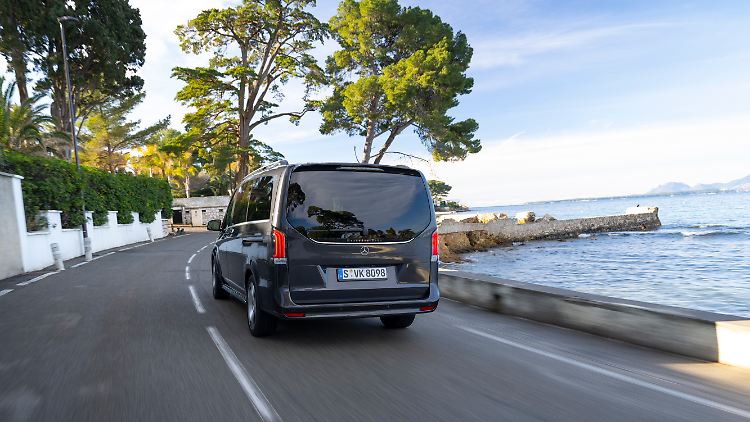

Optically slightly adjusted taillights and the fine Mercedes-Benz lettering below the rear window represent the latest vintage of the V-Class.
(Photo: Mercedes)
I'm starting with a V 300d and rear-wheel drive – because it doesn't always have to be two driven axles. Namely saves weight and fuel. And just like when I was driving along, I can also hear the mildly whirring four-cylinder with the code OM654 in front. Now, however, I have the power over the 237 hp powerhouse and, above all, over a concentrated 500 Newton meters of torque just from idle. So sovereignty is when you feel like you only move the right pedal a few millimeters and thus exert gentle force on the cross without letting the nine-speed automatic torque converter shift down. And if she does, she succeeds in a smooth manner. The spacious 2.6-ton truck is also economical with a maximum of 8.4 liters of diesel fuel per 100 kilometers.
Switching to the silent EQV. Swap excess weight (but not even 100 kilograms) for reduced performance and see what happens. There is “only” 204 hp and 362 Newton meters here, but that doesn't detract from the aforementioned sovereignty. As is well known, electric machines are characterized by high elasticity; And so the EQV also benefits from the fact that it doesn't have to change gear ratios and simply pulls ahead unwaveringly up to the limited top speed of 160 km/h. In contrast, the diesel with 220 things is a pretty nice express van. The weakness of the electrically powered V-Class is still its not-so-excessive range and relatively poor charging performance. It's exciting that Mercedes is already advertising the “Van.EA” platform in the press kit, which will be launched in 2026 and will then impress with 800 volts.
Charging performance no longer up to date
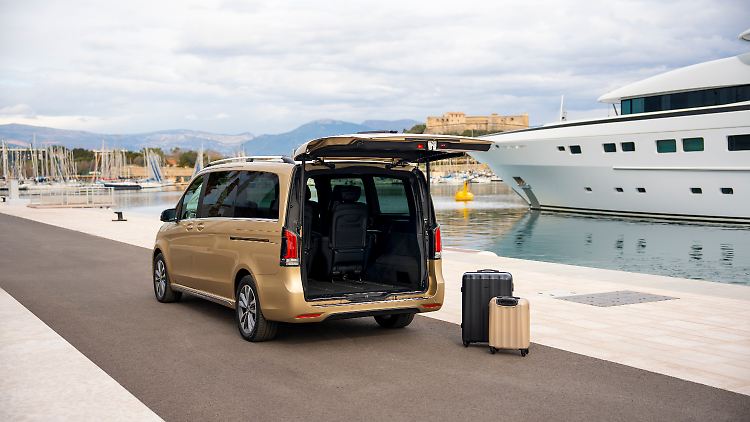

Big hatch and a lot behind it: Depending on the seat configuration, hundreds to thousands of liters can fit in the luggage compartment.
(Photo: Mercedes)
Current EQV customers, on the other hand, have to be content with the fact that the engineers have worked on the thermal management or revised it. The system now uses the waste heat from both the battery and the electric machine to further increase efficiency. But a look at the combined range of 365 kilometers (WLTP) shows that the expansive Benz has to be plugged in more often – it's just not as aerodynamic as a sports car. And its 90 kWh battery (net) only charges with just over 100 kW at peak. The latest MBUX generation is little consolation. After all, it takes charging stops into account when navigating, taking into account many parameters such as electricity consumption (on average around 27 kWh per 100 kilometers), topography and traffic.
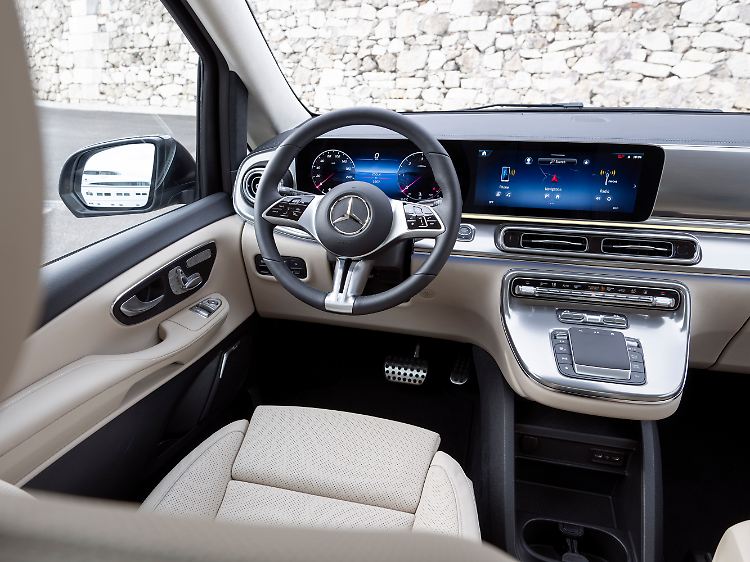

Now there is also the large “widescreen” for the V-Class.
Anyone who is unhappy with both diesel and electric versions will soon be able to choose a 231 hp two-liter gasoline engine. The four-cylinder does its work quietly (thanks to good insulation) and cheerfully, and is also mildly hybridized and therefore boosts with an additional 20 electrical horsepower. If you drive in Eco mode, the combustion engine switches off consistently when you lift the accelerator pedal. The large arsenal of assistants is the same for all drive variants. Incidentally, the Mercedes team on site promotes the lane keeping assistant, which supposedly works more smoothly with active steering (instead of braking interventions). Fortunately, it can be switched off quickly on the so-called widescreen. These are the two 12.3-inch display units that are familiar from Mercedes in other model series, but are now being used for the first time in the V-Class, of which the one on the right side is touch-sensitive.
V-Class now with hood ornament
Do you need further decision-making help? While the classic brand face with a star as a hood ornament is increasingly being omitted from conventional Mercedes passenger cars, for the first time in history a van can enjoy exactly this benefit: If you choose the “Exclusive” equipment line, the upright star is always included. However, there is a small downer – this option does not exist in conjunction with an electric drive. Do the marketing strategists think the hood ornament faction is too conservative to ever decide on an EQV? The “Electro” team will at least have the illuminated radiator grille, which is also fancy. And there are 64 different colors to choose from for the ambient lighting.
And digital natives can expect powerful voice control. Although ChatGPT is still missing in this generation, the system still understands mumbled speech excellently and also answers questions beyond automotive matters. “How many inhabitants does Paris have?” I ask at the end. The answer comes promptly.
With a starting price of 57,483 euros, the V-Class, which is blessed with a lot of utility value, is no bargain. Then the comfortable utility professional rolls to the start with a 163 hp diesel in a compact length of 4.90 meters. Regardless of your budget, you should consider whether you should go for the longest version (5.37 meters), given that parking space is becoming increasingly scarce despite the camera system with razor-sharp imaging. The latest version of the V-Class also offers you spoiled for choice. And after what is presumably the last refresh, it is fit for the future. At least that will probably still apply to the combustion engine models when Mercedes moves into a new electric age with “Van.EA” in two years.































